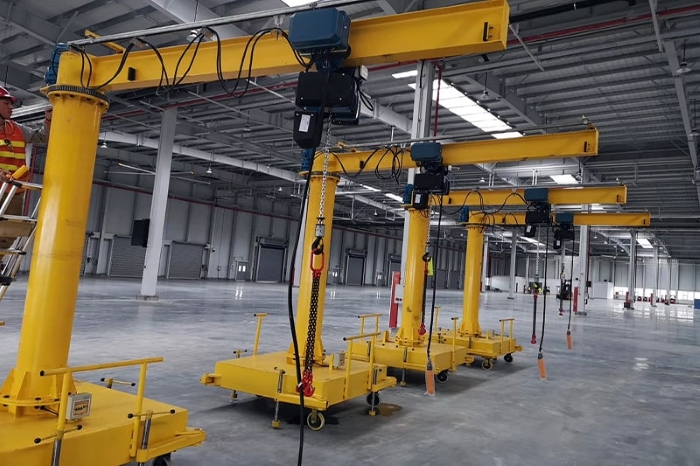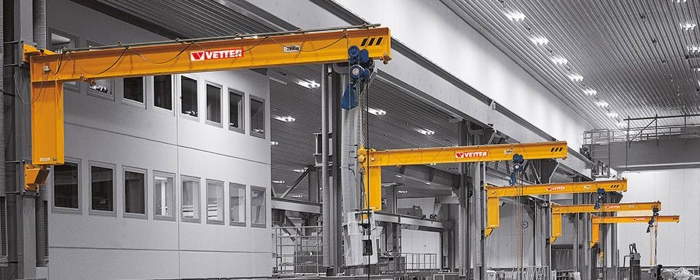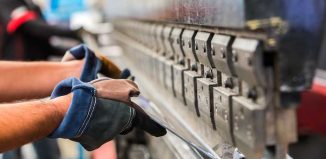There will be dozens of cases where one or several employees will find it hard to lift items regularly used in the workplace. This can be engine parts in a workshop, crates and boxes in warehousing and general storage, and any object just too heavy and in multiple work environments. If there’s the need to do this regularly, then tasks soon become tiring if not impossible. Small and versatile lifting crane jibs can be installed in almost any setting, and complete heavy and repetitive lifting jobs safely and in the least amount of time.
What are Jib Cranes?
A jib crane is a type of overhead lifting device used in moving, lifting and lowering material. They’re used across many industries and businesses, from mines and factories, production and fabrication lines, automotive workshops, warehouses and material handling facilities and anywhere where heavy loads need lifting and repositioning. The simple design, consisting of two basic parts – a mast or mount and a beam or crane jib, dates back to antiquity, first used by the Ancient Greeks, and later by the Romans in road construction and large engineering projects. Designs and uses have been refined throughout the ages, but the basic principle of how jib cranes work remains the same.

Parts and How it Works?
Jib cranes get their name from the horizontal or near-horizontal beam or jib that supports the weight of the load. This can have a movable trolley along its length, used on its own, or have other specialised attachments used in lifting and moving different loads. The beam or jib is supported by a vertical beam, otherwise known as a mast or wall-mounted pillar found in freestanding and mast mount crane systems. Loads are lifted off the ground and repositioned or lowered using a hoist. A trolley carries the hoist, as well as the wire or chain and this can terminate in a hook to which the load is attached. Hooks can be lowered and lifted to different heights.
Hoists can be pneumatic or electrically powered operated using control buttons to control the motion of the trolley along the jib, and the rotation of the jib. Push buttons also control the lifting and lowering of loads. Some units may have varying speeds, so repetitive work with lower weights can be handled quicker, and larger loads can be lifted and positioned with utmost safety. Other safety features include a rotation stop that prevents the jib from colliding with nearby items or structures.
Operation includes three types of movement. Rotational movement refers to the movement of the jib about the mast or mount. Freestanding crane jibs have a full 360-degree rotation, while wall-mounted variants can swivel up to 180 degrees. Traverse motion refers to the movement of the trolley and hoists along the length of the jib. Vertical or lift motion is the up and down movement of the load.
Types of Jib Cranes
The variety of jib cranes means that you’ll find a lifting mechanism for your application and setting. The most common are freestanding jib cranes as these can be installed almost anywhere, both indoors and outdoors. The crane jibs come in different boom lengths, have full rotation, varying lifting capacities and can be mounted relatively high.
There are three types of freestanding jib cranes – those that have the mast that is bolted into a concrete base mount and reinforced with gussets, those that are foundation mounted and sleeve insert mounted jib cranes, with the mast fitting into sleeves cemented into the foundation. The benefits of freestanding jib cranes are that they have some of the largest lifting capacities, have the longest jibs, and offer the most flexibility in positioning loads due to the high rotation.

Another common design is the wall-mounted jib crane. These usually sit along load-bearing structural columns. The advantages here are that they can be used where space is limited and can be set at ceiling height for high clearances, so the space below is unaffected. The downsides are the limited rotation and lower loading capacities of jibs.
Related to freestanding cranes are foundationless jib cranes that are suitable for use indoors, These are what you’ll find in smaller workshops, as the lifting capacity is limited to 2 tonnes in the jib, but still offer full rotation. These are the most cost-effective and easiest to install.
Choosing the Right Jib Crane for Your Application
There are several criteria when selecting the jib crane for your needs. First ensure that masts, hoists, jibs and other components are rated to Australian Crane Standards (AS1418). This ensures that the cranes will be durable enough to work to the specified loads. Next, consider the level of rotation required and the space available. This will narrow down your choices as to the type of crane suitable for the setting. Smaller foundationless cranes are those that are in higher demand, and the loading capacity in the jib will be more than suitable for most applications. Most will also have enough height in the mast so the jib doesn’t obstruct everyday operations. Lastly consider how you will be powering the crane and whether this is suitable for the setting (indoors or outdoors).











